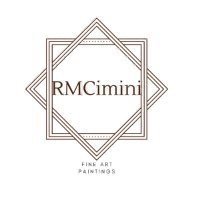Giving Attention
I often say that my art practice is a sacred act, and I'd like to share why.
I follow the teaching of philosopher Simone Weil, who believed that pure, undivided attention transforms even the most ordinary moment into something holy. When you stay fully present to a moment, a task, a person, or even your own pain, you're not just "doing or being"—you're offering a kind of silent devotion that changes both you and the world around you.
We turn noise into clarity by paying attention, turn chaos into order, and longing into aligned action. Every time we consecrate a small act with our full awareness, we're practicing a form of prayer that ripples out into our choices, our relationships, and our creative work.
This is what I bring to each painting—not just technique or vision, but this quality of sacred attention that transforms pigment and canvas into something deeper.
Attention is active—it shapes what you feel and what you choose. When you give full attention, the noise drops away and the next right step becomes clear. In this space of focused awareness, feeling settles and aligned choices emerge naturally. When you focus your attention, you act from a centered state.
This is essential to my painting process. I focus on the work, settle into stillness, and simply receive the painting I've been working on. As I look and continue to look, clarity comes. I see the next step, then the next, each one leading forward.
You do not need to be an artist to bring attention to your actions. You can practice this in everyday life. Put an object in front of yourself or choose a simple task. Breathe calmly and say, "I will give this my full attention"—whether it's sunlight through the window, doing laundry, making your bed, or washing dishes. Look closely, move slowly, let the task set the pace. When your mind wanders (and it will, even within a minute or two), gently acknowledge this and return to the state of presence with what you're doing.
Finally, release the outcome.
This release of the outcome is crucial in painting. If I'm worried about what my work will look like, whether someone will buy it, or if a gallery will show it—if I'm seeking any outside validation—the work suffers terribly. But when I stay present and follow the painting's lead, something authentic emerges. I don't always know where things are going (I often don't). I remind myself that my best work comes when I can't see the way forward, when I don't understand what I'm painting, when I trust the process.
Because of this, paintings can take months to develop. Am I happy about that? Not particularly. But I'm not in the business of producing paintings as products—I'm creating to communicate from my soul to your soul.
This works with relationships, also. When you listen to someone speak, or read a message, especially if you feel anger or frustration rising, take deep breaths. Notice the tone and intention behind their words. Often, what triggers us isn't what the person actually said—it's how we receive it based on our mood in that moment. Once you breathe and pay attention, you will find your center and be able to respond from a state of presence rather than a state of reaction.
I know all about this because I practice this frequently when my first response is sometimes judgmental or personal, and I know that a negative reaction won't serve anyone.
Why does this work? Because paying attention helps you reduce the noise and get to the signal, to what truly needs to be heard. Your choices coming from a centered place will be kinder and more deliberate.
Anais Nin said
"It is the function of art to renew our perception. What we are familiar with we cease to see. The writer shakes up the familiar scene, and, as if by magic, we see a new meaning in it".
This is not just for writers, but for all of us.
So, give full attention, allow stillness in yourself, then take one step. All you need is one step, and trust—you're not responsible for the outcome.

